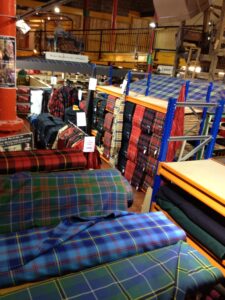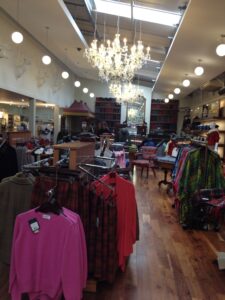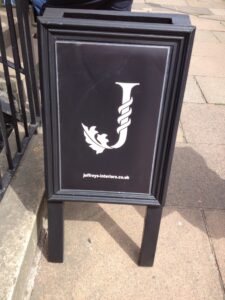Pin It One of the joys of this particular trip to Europe is that I could combine research for That Autumn in Edinburgh (the follow-on novel to That Summer in Cornwall ) with a search for some of my husband and my families’ more obscure tartan patterns. In our joint two clans, we have the Scottish names McCullough, McVicker, McAllister/Alexander, McGann, Hunter, Pattison, Harris, Brown, Gibbs, Forester, and Bell.
One of the joys of this particular trip to Europe is that I could combine research for That Autumn in Edinburgh (the follow-on novel to That Summer in Cornwall ) with a search for some of my husband and my families’ more obscure tartan patterns. In our joint two clans, we have the Scottish names McCullough, McVicker, McAllister/Alexander, McGann, Hunter, Pattison, Harris, Brown, Gibbs, Forester, and Bell.
My husband Tony’s surname is “Cook,” and he always assumed it was of solid, English origin.
“Oh, indeed not,” his late father, Howard Cook, declared emphatically a number of years ago. “We were the MacCooks, but they lopped off the Mac to make us sound more American.”
I speedily went online and did a search for tartan names and found it–voila–as “Cook/MacCook.”
And then, long after we were married, we discovered that we both had the name “Bell” in our family lines. Turns out on this trip that that we learned there are a number of Bell regional tartans, but the most colorful one both Cook and Ware family members have been emailing me about has prompted them to ask if we all could coordinate and make a single, combined order for yardage? (I imagine there may be a number of sofas and upholstered arm chairs dotting California’s interior landscape soon…)
The answer was given me: yes we can make a special order, and so can many tartan-loving souls by contacting D.C. Dalgliesh, one of the last traditional mills remaining in operation that are willing to do custom orders for the lesser known patterns–and will do a “run” for fewer than 30 meters, when most mills won’t bother with a set-up for less than that amount of yardage–and prices vary widely from mill to mill.
 The sad truth, we discovered as we made our ways through the stunning Tweed Valley where the textile trade once thrived, is that many of the mills that had manufactured tartans and other woolens for some two centuries have fallen to the onslaught of cheap, often inferior goods manufactured in the Far East. Other companies have, themselves, sold out to overseas manufacturers who apparently desire the cachet of a “Made in Scotland” label to further their global reach.
The sad truth, we discovered as we made our ways through the stunning Tweed Valley where the textile trade once thrived, is that many of the mills that had manufactured tartans and other woolens for some two centuries have fallen to the onslaught of cheap, often inferior goods manufactured in the Far East. Other companies have, themselves, sold out to overseas manufacturers who apparently desire the cachet of a “Made in Scotland” label to further their global reach.
Just recently, E-Land of South Korea bought Lochcarron weavers and the sister-company, Peter Scott, a cashmere operation based in the Scottish Borders region. So far, everything made in these factories appears to be of the highest quality, though some of the goods are already being designed with the Japanese, Chinese, and Korean markets and sensibilities in mind.
 Interestingly, some indigenous Scottish textile companies that are managing to survive and even thrive, such as Johnstons of Elgin (and Hawick, south of Edinburgh and having last week earned the Royal Warrant), tend to be the ones catering to the high-end, luxury market that demands top quality merchandise–and can recognize it when they see it. With price usually no object, these buyers want items made in Scotland by the Scottish! One other very noteworthy development is a company called ScotWeb that offers many varieties of Scottish goods for online purchase.
Interestingly, some indigenous Scottish textile companies that are managing to survive and even thrive, such as Johnstons of Elgin (and Hawick, south of Edinburgh and having last week earned the Royal Warrant), tend to be the ones catering to the high-end, luxury market that demands top quality merchandise–and can recognize it when they see it. With price usually no object, these buyers want items made in Scotland by the Scottish! One other very noteworthy development is a company called ScotWeb that offers many varieties of Scottish goods for online purchase.
Behind a modest wood stairway in Edinburgh leading up to a large warehouse, Dr. Nick Fiddes is sourcing genuine Scottish goods to customers based all over the globe. He is also a tech wizard offering his expertise to a quasi governmental agency, the Scottish Register of Tartans, to create a giant database of known tartans (and the “recipes” to make them on existing looms) to help the diaspora of Scots living in the far corners of the globe to track down their family tartans or buy goods with obvious Scottish origins. This was the same database where I found the unusual version of the Bell tartan.
 Scotweb recently purchased the old-school weaving company, DC Dalgliesh, that owns perhaps the largest library of tartan patterns in the world and will also help a customer design a brand new tartan for a family or business entity desiring one of their very own.
Scotweb recently purchased the old-school weaving company, DC Dalgliesh, that owns perhaps the largest library of tartan patterns in the world and will also help a customer design a brand new tartan for a family or business entity desiring one of their very own.
A big push, thanks–rather ironically, it seems to me–to Bronx-born garment and home furnishing designer Ralph Lauren is the use of tartans in American home furnishings. On this trip I discovered that the RL label even plays big in the stately homes and manors here in Scotland.
But more on that fascinating story in a future blog post…
Filed under Blog, Ciji's Archives · Tagged with D.C. Dalgliesh, family tartan, heritage tartans, Johnstons of Elgin, Lochcarron, Scottish history, tartan home furnishings, tartans, That Autumn in Edinburgh, That Summer in Cornwall, women's fiction, woolen textiles, woolens manufacturing
Pin It I often am asked, “Do you base some of your characters on real people?” Well, fictional characters are just that: made up in the author’s mind. However, there’s no denying that there are often ‘real life’ figures who sometimes serve as inspiration. And, as I learned this year writing That Summer in Cornwall, the same goes for dog characters.
I often am asked, “Do you base some of your characters on real people?” Well, fictional characters are just that: made up in the author’s mind. However, there’s no denying that there are often ‘real life’ figures who sometimes serve as inspiration. And, as I learned this year writing That Summer in Cornwall, the same goes for dog characters.
However, just to show how tricky a subject this is, you should know that this Border Collie actually is known by another name as a ‘real-life’ member of the Cornwall Search and Rescue Team… In my novel, the Border Collie T-Rex–aka Rex–became the name I gave my hero Sebastian Pryce’s dog after I met this dog, seen here having coffee at the famous Poggio’s Trattoria .
Say hello to the real T-Rex…the Great Dane, affectionately known by his intimates as “The Mayor” of a maritime village in the San Francisco Bay Area. This big boy truly was what inspired my naming this important search-and-rescue dog who figures prominently in the novel.
(Well…at least, both boys’ coats are black and white).
 And both animals have tremendously good hearts—to say nothing of their amazing noses—and, of course, I asked permission of the original T-Rex’s mistress, artist Lucinda O’Connell, if I could “borrow” his moniker.
And both animals have tremendously good hearts—to say nothing of their amazing noses—and, of course, I asked permission of the original T-Rex’s mistress, artist Lucinda O’Connell, if I could “borrow” his moniker.
And then there was the heroine’s dog, a sheep-herding Corgi from the pastures of Wyoming. The sassy, smart little dog started out in the first draft with the name of “Jasper”—called that in honor of my godchildren’s ‘real-life’ Corgi.
But there was just one problem: Jasper the Corgi is a boy dog with a boy dog’s name, and as I got into the plot, there were some very compelling reasons to make “him” a “her”—especially since the two dogs have a memorable “meet-up” in Chapter One—much to their human companions’ chagrin.
Therefore, in urgent need of an appropriately feminine name, the first thing that popped into my head was my friend, romance writer Cynthia Wright ’s late, great black lab, seen here with her daughter, Jenna. So “Jasper” was transformed, via a “global search and replace” on my Mac, into “Holly”– along with profuse apologies to my godchildren Andrew and Grace.

So, there you have it! Life in the fictional world can be just as rough as Hollywood…and some of the best performers are left on the cutting room floor…
Filed under Blog, Ciji's Archives · Tagged with blogger, Border Collie, Ciji Ware author, contemporary fiction, corgis, Cornwall, Cornwall Search and Rescue Team, Cynthia Wright Author, dogs in fiction, Great Danes, Jenna Francisco, search and rescue dogs, That Summer in Cornwall, truth versus fiction, women's fiction
Pin It
I admit it: over the years, I’ve become a rather obsessed “cottage collector.” Perhaps it’s because, at around ten years old, I began visiting my Grandfather Ware at the tiny stone cottage perched on a sand dune on Carmel Beach that he rented the same year we moved as a family from Los Angeles to the amazing village of Carmel-by-the-Sea. My father, writer Harlan Ware, would escort me along the streets-with-no-sidewalks to the Forest, Studio, and Golden Bough theatres thriving in our town where I would perform in semi-professional plays when I was growing up. We’d pass by cottage after cottage that could have served as illustrations in the Book of Mother Goose. Cottage life, to me, seemed an idyllic way to live, even during the years when I dwelled in the cities of New York, Los Angeles, and San Francisco.
My father, writer Harlan Ware, would escort me along the streets-with-no-sidewalks to the Forest, Studio, and Golden Bough theatres thriving in our town where I would perform in semi-professional plays when I was growing up. We’d pass by cottage after cottage that could have served as illustrations in the Book of Mother Goose. Cottage life, to me, seemed an idyllic way to live, even during the years when I dwelled in the cities of New York, Los Angeles, and San Francisco.
 So, when I first walked through this gate fifteen years ago on the central coast of Cornwall, England on a research trip for A Cottage by the Sea, I knew this was the perfect spot to set this story and had in my mind exactly how the fictional “Painter’s Cottage” should look. It would be a stone structure with a slate roof and floor-to-ceiling artists’ windows facing the English Channel. However, on that day, all I could see across a broad field was a tiny structure clinging to the cliff on a curving bay between Nare Head on the West and Dodman Point to the East.
So, when I first walked through this gate fifteen years ago on the central coast of Cornwall, England on a research trip for A Cottage by the Sea, I knew this was the perfect spot to set this story and had in my mind exactly how the fictional “Painter’s Cottage” should look. It would be a stone structure with a slate roof and floor-to-ceiling artists’ windows facing the English Channel. However, on that day, all I could see across a broad field was a tiny structure clinging to the cliff on a curving bay between Nare Head on the West and Dodman Point to the East.

As I picked my way across the loamy turf, I began to make out what was actually an abandoned “lookout” stone structure, a small, squat building–and in 1997, minus a roof. Never mind, I thought, enraptured by the sweeping view and the sheep and Scottish Highland cattle dotting the slope, this was the place I would build my perfect cottage in my imagination. On another research trip years later to prepare for the sequel, That Summer in Cornwall, the field’s owner—the Caerhays Castle estate–had recently restored the roof, perhaps in the hope they could add it to a list of estate outbuildings they offer to paying guests. Luckily for me, I had that privilege last October at Bottom Lodge…once the gatekeeper’s cottage.
 Talk about a novelist surrounding herself with the atmosphere of the place she would write about! This is “Bottom Lodge” where visitors to Caerhays Castle (aka “Barton Hall” in my two novels set in Cornwall) can book into the left turret. I was “in residence” in October of 2012 and it was totally an experience of a lifetime! I spent my days tramping all over the estate, reveling in what it must have actually been like to live here a hundred and fifty years ago, and also got a solid grasp of what a struggle it is in the modern world to keep these big houses solvent.
Talk about a novelist surrounding herself with the atmosphere of the place she would write about! This is “Bottom Lodge” where visitors to Caerhays Castle (aka “Barton Hall” in my two novels set in Cornwall) can book into the left turret. I was “in residence” in October of 2012 and it was totally an experience of a lifetime! I spent my days tramping all over the estate, reveling in what it must have actually been like to live here a hundred and fifty years ago, and also got a solid grasp of what a struggle it is in the modern world to keep these big houses solvent.
 In the two, stand-alone novels (and certainly in my mind), I easily expanded the small structure I’d spotted perched on the cliff into a two-story cottage with a sleeping loft and a faintly baronial fireplace opposite windows facing the English Channel–and no cattle wandering in and out! (This cottage with the sailboat actually exists in Talloires, France–but I loved the fireplace and imagined it as part of Painter’s Cottage!) On my most recent trip to the environs of Gorran Haven in central Cornwall, I dared to get pretty close to those long-horned Scottish Highland cattle who’d made the old stone lookout hut their personal shelter…and what a view! Beyond those clouds, that’s Brittany across the English Channel…
In the two, stand-alone novels (and certainly in my mind), I easily expanded the small structure I’d spotted perched on the cliff into a two-story cottage with a sleeping loft and a faintly baronial fireplace opposite windows facing the English Channel–and no cattle wandering in and out! (This cottage with the sailboat actually exists in Talloires, France–but I loved the fireplace and imagined it as part of Painter’s Cottage!) On my most recent trip to the environs of Gorran Haven in central Cornwall, I dared to get pretty close to those long-horned Scottish Highland cattle who’d made the old stone lookout hut their personal shelter…and what a view! Beyond those clouds, that’s Brittany across the English Channel…
The vistas through the abandon lookout’s glass-less windows were even more incredible. Imagine, I thought, if the Caerhays Estate eventually rehabs this stone lookout and allows their “paying guests” to stay here as they did with bottom Lodge? But I loved the location so much, I decided as I was writing That Summer in Cornwall that the heroine would claim the “newly rehabbed” Painter’s Cottage for her own while she pitched in to help her Anglo-American cousins return the eight-hundred-acre estate to solvency.
 I could easily imagine the overstuffed furniture in front of a cozy fireplace, surrounded by the magnificence of the Cornish coast. To me, Painter’s Cottage truly exists as part of a shabby-chic castle clinging to a remote Cornish cliff–even if all you can see if you visit there this very day is a small, squat, abandoned stone hut that may one day see new life again.
I could easily imagine the overstuffed furniture in front of a cozy fireplace, surrounded by the magnificence of the Cornish coast. To me, Painter’s Cottage truly exists as part of a shabby-chic castle clinging to a remote Cornish cliff–even if all you can see if you visit there this very day is a small, squat, abandoned stone hut that may one day see new life again.
In a novelist’s mind, anything is possible…
Filed under Blog, Ciji's Archives · Tagged with A Cottage by the Sea, Caerhays Castle, Carmel cottages, Carmel-by-the-Sea, Ciji Ware author, contemporary fiction, contemporary women's fiction, Cornwall, cottage, cottage decor, cottage life, cottage living, eighteenth century British history, historical novels, romance novel, That Summer in Cornwall, women's fiction
 One of the joys of this particular trip to Europe is that I could combine research for That Autumn in Edinburgh (the follow-on novel to That Summer in Cornwall ) with a search for some of my husband and my families’ more obscure tartan patterns. In our joint two clans, we have the Scottish names McCullough, McVicker, McAllister/Alexander, McGann, Hunter, Pattison, Harris, Brown, Gibbs, Forester, and Bell.
One of the joys of this particular trip to Europe is that I could combine research for That Autumn in Edinburgh (the follow-on novel to That Summer in Cornwall ) with a search for some of my husband and my families’ more obscure tartan patterns. In our joint two clans, we have the Scottish names McCullough, McVicker, McAllister/Alexander, McGann, Hunter, Pattison, Harris, Brown, Gibbs, Forester, and Bell.

 The sad truth, we discovered as we made our ways through the stunning Tweed Valley where the textile trade once thrived, is that many of the mills that had manufactured tartans and other woolens for some two centuries have fallen to the onslaught of cheap, often inferior goods manufactured in the Far East. Other companies have, themselves, sold out to overseas manufacturers who apparently desire the cachet of a “Made in Scotland” label to further their global reach.
The sad truth, we discovered as we made our ways through the stunning Tweed Valley where the textile trade once thrived, is that many of the mills that had manufactured tartans and other woolens for some two centuries have fallen to the onslaught of cheap, often inferior goods manufactured in the Far East. Other companies have, themselves, sold out to overseas manufacturers who apparently desire the cachet of a “Made in Scotland” label to further their global reach.
 Interestingly, some indigenous Scottish textile companies that are managing to survive and even thrive, such as Johnstons of Elgin (and Hawick, south of Edinburgh and having last week earned the Royal Warrant), tend to be the ones catering to the high-end, luxury market that demands top quality merchandise–and can recognize it when they see it. With price usually no object, these buyers want items made in Scotland by the Scottish! One other very noteworthy development is a company called ScotWeb that offers many varieties of Scottish goods for online purchase.
Interestingly, some indigenous Scottish textile companies that are managing to survive and even thrive, such as Johnstons of Elgin (and Hawick, south of Edinburgh and having last week earned the Royal Warrant), tend to be the ones catering to the high-end, luxury market that demands top quality merchandise–and can recognize it when they see it. With price usually no object, these buyers want items made in Scotland by the Scottish! One other very noteworthy development is a company called ScotWeb that offers many varieties of Scottish goods for online purchase.
 Scotweb recently purchased the old-school weaving company, DC Dalgliesh, that owns perhaps the largest library of tartan patterns in the world and will also help a customer design a brand new tartan for a family or business entity desiring one of their very own.
Scotweb recently purchased the old-school weaving company, DC Dalgliesh, that owns perhaps the largest library of tartan patterns in the world and will also help a customer design a brand new tartan for a family or business entity desiring one of their very own.




























